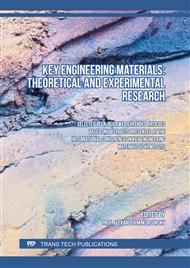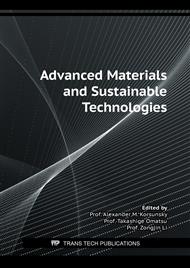[1]
Azarpira, H., Mahdavi, Y. (2016). Removal of cd (II) by adsorption on agricultural waste biomass. Der PharmaChemica. 2016;8(12); 61-67.Balarak, D., Azarpira, H., Mostafapour, F.K. Thermodynamics of removal of cadmium by adsorption on barley husk biomass. Der PharmaChemica. 2016; 8(10); 243-247.
Google Scholar
[2]
Järup L. (2003), Hazards of heavy metals contamination, British Medical Bulletin, 68;167–182.
DOI: 10.1093/bmb/ldg032
Google Scholar
[3]
Fu, F., Wang, Q. (2011), Removal of heavy metal ions from wastewaters: A review. J.Environ. Manag., Vol. 92, pp.407-18.
Google Scholar
[4]
Sud, D., Garima Mahajan, G., Kaur, M.P., (2008). Agricultural waste material as potential adsorbent for sequestering heavy metal ions from aqueous solutions – A review, Bioresource Technology, Vol. 99, no 14, pp.6017-6027.
DOI: 10.1016/j.biortech.2007.11.064
Google Scholar
[5]
Wang J, Chen C. (2009), Biosorbents for heavy metals removal and their future. Biotechnology Advances. Vol. 27; p.195–226.
DOI: 10.1016/j.biotechadv.2008.11.002
Google Scholar
[6]
Srivastava, N.K. and Majumder, C.B., (2008) Novel biofilteration methods for the treatment of heavy metals from industrial waste water. Journal of Hazardous Materials, Vol. 151(1), pp.1-8.
Google Scholar
[7]
Gupta V.K., Jain C., Ali I., Sharma M., Saini V., (2003), Removal of Cadmium and Nickel from Wastewater Using Bagasse Fly Ash—a Sugar Industry Waste, Water Res., Vol. 37(16), pp.4038-4044.
DOI: 10.1016/s0043-1354(03)00292-6
Google Scholar
[8]
Abas Siti N., Mohd Halim S., Md Lias K. and Shamsul I., (2013), Adsorption process of heavy metals by low cost adsorbents: A review. (2013), World Applied Sciences Journal, Vol. 28 (11): 1518-1530.
Google Scholar
[9]
Taty-Costodes V.C., Fauduet H., Porte C., Delacroix A., (2003). Removal of Cd (II) and Pb (II) Ions, from Qqueous Solutions, by Adsorption onto Sawdust of Pinus Sylvestris, J. Hazard. Mater., Vol. 105(1), pp.121-142.
DOI: 10.1016/j.jhazmat.2003.07.009
Google Scholar
[10]
Saifuddin M., Kumaran P., (2005). Removal of Heavy Metal from Industrial Wastewater Using Chitosan Coated Oil Palm Shell Charcoal, Electron. J. Biotechnol., Vol. 8(1), pp.43-53.
DOI: 10.2225/vol8-issue1-fulltext-7
Google Scholar
[11]
Zazouli M.A., Yousefi Z., Taghavi M., Akbariadergani B., Cherati J.Y., (2013) Cadmium Removal from Aqueous Solutions using L-cysteine Functionalized Single-Walled Carbon Nanotubes, J. Mazand. Univ. Med. Sci., Vol. 23(98), pp.37-47.
Google Scholar
[12]
Mousavi H. Z., Hosseynifar A., Jahed V., Dehghani S. A. M., (2010). Removal of Lead from aqueous Solution using waste Tire Rubber Ash as an Adsorbent, Brazilian Journal of Chemical Engineering, Vol. 27, No. 01, p.79–87.
DOI: 10.1590/s0104-66322010000100007
Google Scholar
[13]
Rohaizar N. A., Hadi N., Sien W. C (2013). Removal of Cu(II) from Water by Adsorption on Chicken Eggshell, International Journal of Engineering & Technology IJET-IJENS Vol:13 No:01.
Google Scholar
[14]
Ahluwalia, S.S., Goyal, D., (2005), Microbial and plant derived biomassfor removal of heavy metals from waste water, Biores. Technol. 98, p.2243–2257.
DOI: 10.1016/j.biortech.2005.12.006
Google Scholar
[15]
El-Asht oukhy E. S., Amin N. K. and O. Abdelwahab, (2008), Removal of lead(II) and copper(II) from aqueous solut ion using pomegranate peel as a new adsorbent ‖, Desalination, Vol. 223, pp.162-173.
DOI: 10.1016/j.desal.2007.01.206
Google Scholar
[16]
Dabrowski A, Hubicki Z., Podkoscielny P. and Robens E., (2004), Select ive removal of t he heavy met al ions from wat ers and indust rial wastewaters by ion-exchange met hod‖, Chemosphere, Vol. 56, pp.91-106.
DOI: 10.1016/j.chemosphere.2004.03.006
Google Scholar
[17]
Horikoshi, T., Nakajima, A., Sakaguchi, T., (1981), Studies on the accumulation of heavy metal elements in biological systems, XIX:accumulation of uranium by microorganisms. Eur. J. Appl. Microbiol. Biotechnol. Vol. 12, p.90–96.
DOI: 10.1007/bf01970040
Google Scholar
[18]
Hosea, M., Greene, B., McPherson, R., Henzl, M., Alexander, M.D., Darnall, D.W., (1986). Accumulation of elemental gold on alga Chlorella vulgaris. Inorg. Chim. Acta, Vol. 123, p.161–165.
DOI: 10.1016/s0020-1693(00)86339-2
Google Scholar
[19]
Balkaya N., Cesur H., Adsorption of Cadmium from Aqueous Solution by Phosphogypsum, (2008), Chem. Eng. J., Vol. 140(1), pp.247-254.
DOI: 10.1016/j.cej.2007.10.002
Google Scholar
[20]
Agarwal, S., Tyagi, I., Gupta, V.K. Asif, M., (2016), Rapid removal of noxious nickel (II) using novel γ-alumina nanoparticles and multiwalled carbon nanotubes: Kinetic and isotherm studies. Journal of Molecular Liquids; Vol. 224; pp.618-628.
DOI: 10.1016/j.molliq.2016.10.032
Google Scholar
[21]
Sud, D., Mahajan, G., Kaur, M.P. (2008). Agricultural waste material as potential adsorbent for sequestering heavy metal ions from aqueous solutions – A review, Bioresour. Technol., Vol.99, pp.6017-27.
DOI: 10.1016/j.biortech.2007.11.064
Google Scholar
[22]
Mahajan, G., Sud, D., (2012), Modified agricultural waste biomass with enhanced responsive properties for metal-ion remediation: a green approach, Applied Water Science, Vol. 2, Issue 4, pp.299-308.
DOI: 10.1007/s13201-012-0050-5
Google Scholar
[23]
Al-Qahtani, Khairia M., (2018), Water Purification using different Waste Fruit Cortex for Heavy Metals Removal, Journal of Taibah University for Science, pp, 700-708,.
DOI: 10.1016/j.jtusci.2015.09.001
Google Scholar
[24]
Kelly-Vargas, K.; Cerro-Lopez, M.; Reyna-Tellez, S.; Bandala, E.; Sanchez-Salas, J.L., (2012), Biosorption of heavy metals in polluted water, using different waste fruit cortex, Physics and Chemistry of the Earth, Volume 37, pp.26-29,.
DOI: 10.1016/j.pce.2011.03.006
Google Scholar
[25]
Orhan Y, Bujukgungor H., (1993) The removal of heavy metals by using agricultural wastes. Water Sci Technol Vol. 28, p.247–255.
Google Scholar
[26]
Reddad Z, Gerente C, Andres Y, Ralet MC, Thibault JF, Cloirec PL, (2002). Ni(II) and Cd (II) binding properties of native and modified sugar beet pulp. Carbohydrate Polym Vol. 49, p.23–31.
DOI: 10.1016/s0144-8617(01)00301-0
Google Scholar
[27]
Arunakumara, K.K.I.U.; Buddhi Charana Walpola , Min-Ho Yoon, (2013), Banana Peel: A Green Solution for Metal Removal from Contaminated Waters, Korean Journal of Environmental Agriculture,.
DOI: 10.5338/kjea.2013.32.2.108
Google Scholar
[28]
Ashraf Ali and Khalid Saeed, (2015), Decontamination of Cr(VI) and Mn(II) from aqueous media by untreated and chemically treated banana peel: a comparative study, Desalination and Water Treatment, 53:13, 3586-3591,.
DOI: 10.1080/19443994.2013.876669
Google Scholar
[29]
K. Sathasivam and M. R. H.M. Haris, (2010) Banana trunk fibers as an efficient biosorbent for the removal of Cd(II), Cu(II), Fe(II) AND Zn(II) from aqueous solutions, Journal of the Chilean Chemical Society, 55(2):278-282.
DOI: 10.4067/s0717-97072010000200030
Google Scholar
[30]
L.J. Kosarek, (1981) Removal of various toxic heavy metals and cyanide fromwater by membrane processes, in: W.J. Cooper (Ed.), Chemistry in WaterReuse, vol. I, Ann Arbor Science, Ann Arbor, MI, p.261–265.
Google Scholar
[31]
Balarak D, Joghataei A. (2016) Der Pharma Chemica, 8(6):96-103.
Google Scholar
[32]
Pino GH, Torem ML (2006), Mineral Eng;19;380–387.
Google Scholar
[33]
Illowsky, B and Dean, S (2013) Introductory Statistics. 1st edition, Open Stax editor. Chapter 2.
Google Scholar
[34]
Mohapatra, D., Mishra, S., Sutar, N., 2010. Banana and its by-product utilization; an overview, J. Sci. Ind. Res. 69, pp.323-329.
Google Scholar
[35]
Emaga, T.H., Robert, C., Ronkart, S.N., Wathelet, B., Paquot, M., (2008). Dietary fibre omponents and pectin chemical features of peels during ripening in banana and plantain varieties, Bioresour. Technol. 99, pp.4346-4354.
DOI: 10.1016/j.biortech.2007.08.030
Google Scholar
[36]
Ashraf Ali and Khalid Saeed, (2016), Phenol removal from aqueous medium using chemically modified banana peels as low-cost adsorbent, Desalination and Water Treatment, Vol 57, Issue 24 , pp.11242-11254.
DOI: 10.1080/19443994.2015.1041057
Google Scholar



